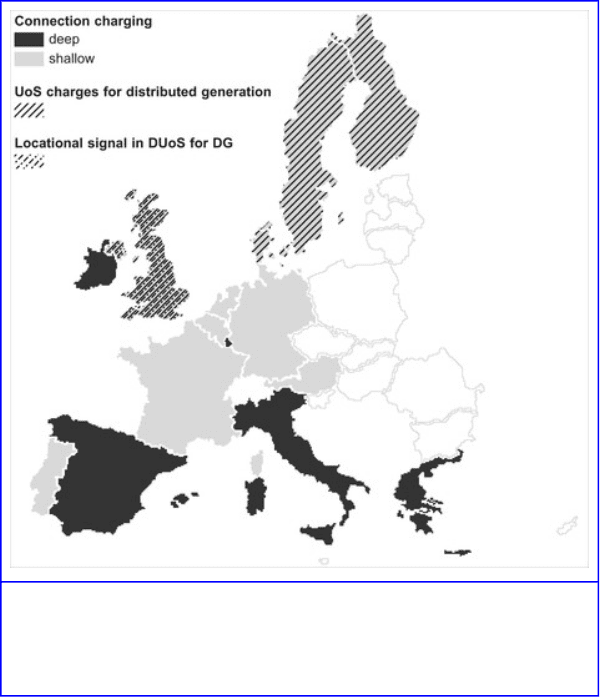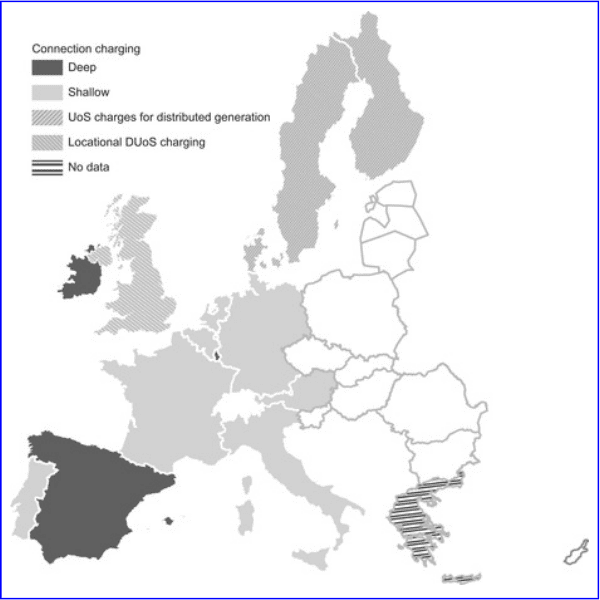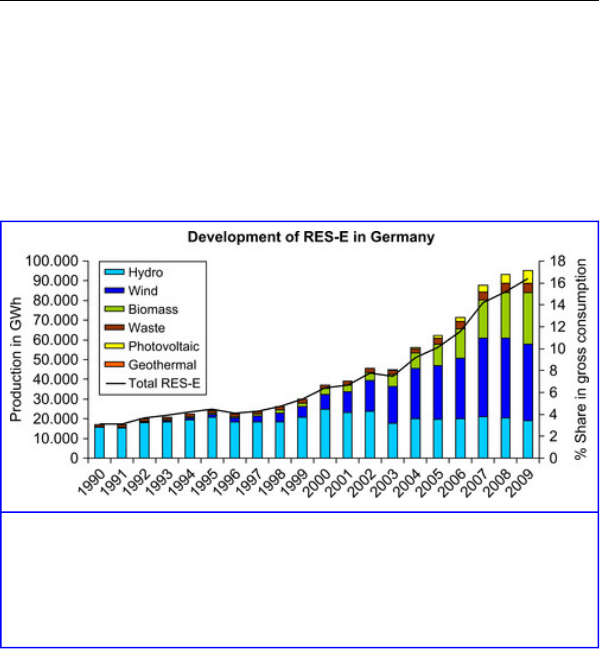Sioshansi F.P. Smart Grid: Integrating Renewable, Distributed & Efficient Energy
Подождите немного. Документ загружается.


7
The specifics, of course, vary from one place to another.
8
The proportions of network and energy cost are different according to
customer group. For industry both the final price (12.29 € ct/kWh) and
the share of network cost (~13%) are significantly lower than for
household customers (23.42 € ct/kWh and ~25% BNetzA [17]).
Figure 13.2
Composition of a household electricity bill in Germany.
Source: Authors, based on data from BNetzA [17]
Electricity prices that vary in different zones reflect the
scarcity of interconnection between regions. This would
641
encourage generators to connect to the network where prices
are high, that is, electricity is scarce. Load is incentivized to
connect in regions with excess supply where prices are low.
This avoids the need for additional interconnection.
Moreover, differences between regions will incentivize
network owners to expand in areas where prices are high. In
practice, however, it can be difficult to demarcate the price
zones, as further described by Björndal and Jörnsten [18].
More precise locational signals originate from nodal spot
pricing, also known as locational marginal pricing (LMP) (for
further explanations see [19] and [20]).
A nodal pricing scheme assigns the overall cheapest supply
option to the demand units at each node. Nodal prices are
calculated by determining the marginal cost for the system of
supplying one additional MW of load at each node, while
taking loop flows into account [21]. A nodal pricing scheme
reflects the topology of the system in detail and thereby takes
into consideration losses and congestion. It has been shown
that nodal prices send efficient signals for short-term
optimization, but insufficient long-term signals. In other
words, they send good signals for the optimization of
operation [19] and [21], but since they do not reflect fixed
network cost, signals are not sufficient to guide efficient
investment decisions [9] and [14].
Nodal spot pricing is often deemed the optimal methodology
for network pricing since it gives first best signals for system
operation, particularly in terms of congestion management.
Indeed, a recent study based on data from U.S. market areas
indicates significant benefits for the move towards nodal
pricing [22]. The benefits typically outweigh the one-off
implementation costs within the first year. However, it seems
642

that this is true for big ISOs but might be problematic for
entities within small market areas. For the UK, Green [23]
estimates the benefits from moving to locational marginal
pricing to be in the range of 1–3% of the generators’
revenues. He points out that the effects strongly depend on
the specifics of a given market but concludes that the gains
might be “worth pursuing”. Today however, these price
differentiations most often only affect industrial customers
since usually retail customers receive flat tariffs from their
suppliers. This may change with more advanced technology,
more granular information on networks costs, and other
functionalities of the smart grid, for example in the
introduction and in Chapter 6, the smart grid vision for
California, in this book.
International Experience with Locational Pricing in
Distribution Networks
In practice, the development towards locational pricing has
thus far concentrated mostly on transmission and the
wholesale level, while applications in distribution networks
are rather rare [14]. However, distribution networks are
moving towards smarter systems that efficiently integrate
both intermittent generation from renewable and distributed
energy sources and a more flexible demand side. These
developments increase the necessity for smart pricing.
Currently, most countries apply shallow connection charges
that convey only few locational signals.
9
However, one can
find examples of deep connection charges or network charges
with locational elements in UoS charges. Yet generation is
often exempted from UoS charges and therefore receives too
643

few locational signals. In general, there is a trend towards
more flexible, less standardized network charges and
negotiated agreements. Figure 13.3 depicts the different
approaches for distribution network charging in the EU-15.
9
In some countries connection procedures include a queuing process for
connection requests, which can also be interpreted as locational signal
[24]. In an area with many other pending connection decisions a request
will typically take longer to be fulfilled if the queue is long. Also the cost
allocation may depend on the queue position, as for example in the
United States [25].
644

Figure 13.3
Distribution charging approaches in the EU-15.
Source: compiled by authors from various sources. *Shallow charges cover direct connection cost
only; deep charges also cover cost for upgrades in the existing network.
An exception is the UK, which uses a more advanced system
of cost-reflective locationally differentiated distribution
use-of-system charges. The UK abandoned deep charging for
connection charges. It was feared that high transaction costs
due to negotiations and informational disadvantages might
hinder the development of distributed generation [26].
Locationally varying UoS charges were implemented in
transmission networks to re-establish the locational signals
that disappeared with the elimination of deep charging. They
are accompanied by shallowish connection charges that cover
the connection cost plus a proportion of the reinforcement
cost.
10
10
In the future, the connection charges might be revised further and
become shallow.
The distribution UoS charging methodology in the UK is
currently moving towards higher cost reflectivity. To enhance
transparency the charging methodologies are published after
obtaining regulatory approval
11
[26]. For low, medium, and
high voltage levels, a Common Distribution Charging
Methodology started in April 2010 [28].
11
This is a European requirement to strengthen the customer's position
[27].
In the distribution reinforcement model, network operators
estimate the cost of network development based on the
expected growth of DG and load. These are the basis for the
calculation of network charges, which are socialized among
645
network users. The model does not feature location-specific
components. Yet it differentiates between demand- and
load-dominated network areas. In the latter the installation of
local generation relieves system stress and avoids network
expansion. Accordingly, the charges for distributed
generation are negative; in other words DG is rewarded.
In the charging methodology for extra high voltage
distribution networks, more explicit locational components
are to be introduced by April 2012 [29].
12
Network operators
can choose between forward cost pricing and long-run
incremental cost pricing. The first method calculates average
forward-looking charges for different network parts that are
not directly connected. Hence the locational signals are
limited to distinct sub-networks. The latter method in contrast
calculates the impact of new DG and new load connection on
the long-run incremental cost of the network for the
differential load at each network node. The resulting
node-specific charges can be positive and negative. They are
scaled by adding a fixed component to ensure cost recovery
while complying with regulatory prescriptions on maximum
allowed revenue.
12
The implementation was originally planned for September 2011 [30],
but the process has been postponed to give network operators more time
to develop satisfactory proposals.
The resulting locational signals are strong, administrative, and
ex-ante. Although charges may vary over time, they are
known at the time of investment and hence create certainty
and transparency. Real-world experience with this approach
still has to be seen, but the positive effects from such signals
are believed to be substantial. Simulations suggest savings in
the order of £200 million over the next 20 years for the UK
646
network. With projected investment in distribution networks
of £3.2 billion per year over the next 20 years [6], this amount
sounds rather low; however, the implementation costs are
estimated to be moderate and the gains might still be worth
pursuing [7].
Explicit use of locational energy pricing—say, nodal or zonal
spot pricing—does not seem to exist at the distribution level
at all. All the known examples are at the transmission level.
This might suggest that in the past locational signals at the
distribution level have not been worth the effort. However,
this is changing as more and more generation enters at the
distribution level. This changes the paradigm of top-down
energy flow and potentially causes congestion in the
distribution network. Therefore benefits from steering
network demand and generation customers to better use
existing network capacity increase. On a theoretical level
Pollitt and Bialek [31] advocate locational energy pricing for
UK distribution networks in the context of regulating for a
low-carbon future. They argue that for distribution networks
the differentiation of several price zones might be a
reasonable initial step, which captures much of the benefit of
more refined locational differentiation.
There are promising developments in the field of demand-side
management. Retailers in New Zealand and the United States,
for example, offer special tariffs for customers on load
control. In the United States, where more and more system
operators are offering demand control programs, the federal
regulator has recently strengthened the position of providers
of demand response [32]. From 2012 providers of demand
reduction will be entitled to receive a remuneration equal to
the market price for generation, when that reduction balances
647
supply and demand and is cost effective. As the wholesale
prices in organized U.S. markets are locationally
differentiated, this incentivizes flexible users where they are
needed. The United States has therefore made a move towards
locational signals within the general pricing system. In
addition, at the state level additional regulations may exist
that further allow individual solutions. In California, for
example, utilities are allowed to offer contracts that ensure the
installation of distributed generation at the right time and in
the right location [33].
13
On the contrary, the development in
New Zealand is rather decentralized and flexible, leaving the
decisions with the retailers.
13
Such contracts can also aim at size or physical assurances needed to
enable a utility to defer a distribution capacity addition. Interestingly,
targeted contracting was seen to obviate the need for additional
locational signals in the general tariffs. The contract system is considered
to retain most of the efficiencies of locational charges while avoiding
“the complications of reversing the long-standing policy of uniform
pricing”[33].
As it is the case in New Zealand, most countries have some
implicit way to steer investments into distributed generation
to reflect the effects on the distribution network and generally
maintain uniform charging. So does Germany, as will be
described in the next section. Partly for other purposes and
partly for exceptional cases, locational pricing can be applied
with strong restrictions by current legislation. The next step
would then be obvious: to allow more locational signals, lift
the restrictions. If the network owners are adequately
incentivized to defer unnecessary network investment, they
will seek locational signals if allowed.
648
Locational Distribution Pricing in Germany
In Germany the share of distributed generation (DG) and
generation from renewable sources in general has increased
rapidly in recent years. This was mainly triggered by the
highly effective feed-in tariffs for renewable generation
(RES-E) and combined heat and power (CHP) [34] and [35].
Like many other countries, Germany is actively promoting
smart grid development and more flexible pricing schemes. It
has now also become clear that facilitating generation from
photovoltaics and wind at the distribution level requires
substantial network expansion. Most studies estimate the
investment need at around €25 billion until 2020 [8] and [36],
which may be on the conservative side. For comparison, in
2008 the overall expenditure of distribution network operators
amounted to €5.57 billion [37].
14
Yet, neither locational
network prices nor locational energy prices are implemented
explicitly at this time. Nor is there political consensus to
move in this direction.
14
This includes operation & maintenance, replacement, expansion, and
investments in new control and information technology [37].
Politicians argue for equal, non-differentiated tariffs to
prevent unfair disadvantages for higher price regions, which
become less attractive for industry. The argument is that
renewable and distributed generation create social benefit,
and hence their integration costs, including network
investment costs, should be socialized. When related to
network charging we observe another problem. Varying
network charges, especially related to peak usage, are not
intuitively understood since the underlying costs are assumed
to be constant. However, peak usage drives the required
capacity and thereby network costs. Of course opportunity
649

cost considerations are the rationale for differentiated tariffs
but often are not perceived as reasonable by customers. Such
positions are a major barrier for locally differentiated prices.
Looking into existing legislation, however, possibilities exist
for introducing locational signals as further described below.
The Challenge: Increasing Renewable Generation in
an Inflexible System
As a result of ambitious feed-in tariffs, Germany has a high
share of renewable electricity amounting to 16.4% of total
gross electricity consumption in 2009 [38]. This share is
projected to increase to 38.6% by 2020 [39] and reach 80% in
2050 [40]. Figure 13.4 shows the development of electricity
generation from renewable sources in Germany since 1990.
Figure 13.4
Development of generation from renewable sources in Germany between 1999
and 2009.
Source: Brandstätt et al. [53]
650
